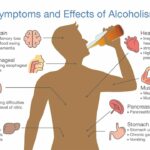In Classical alcoholic terms the person drinks too much and his life is thrown out by his consumption. But it isn’t always real. Some folks appear fine despite drinking. The experts call these people “functioning” or “highfunctioning” alcoholics. It may seem impossible if you still work out outside of your life. Find out what is a good indicator for highfunction drinking.

With excessive alcohol consumption, this important organ can’t metabolize Vitamin D, which could develop into a deficiency. Some common signs and symptoms of cirrhosis include fatigue, itchy skin, weight loss, nausea, yellow eyes and skin, abdominal pain and swelling or bruising.
What is a High Functioning Alcoholic?
When people are commonly labelled syphilis or “high-functioning alcoholics”, these can be easily managed without displaying clinical impairments. However, if consuming alcoholic beverages causes less external consequences, the person will still have to seek professional advice.
However, the proper way to address such a person is to say they have an alcohol use disorder . An alcohol use disorder is a treatable chronic medical disorder that causes long-term changes in the brain that make it difficult to control drinking without leading to clinically significant impairment or distress.
Are you in denial?
A functional alcoholic can’t be acting on what one expects him to be doing, says Benton. Surely his actions are accountable or productive. The man can become highly successful and have power over other persons. He’s likely a good example of a man who doesn’t like drinking too much. It’s possible his actions were denial. He’d probably say he’s got good employment, has plenty of friends and is not alcoholic. He can also give reasons for drank cheap wines or say I have no problems drinking. But it doesn’t work out well for the doctor, Robert Huebner said.
Finding Detox and Treatment
It’s not always easy to get sober. It is best to find a good rehab facility. The first step is to locate a rehabilitation center that offers a detoxification system that allows removing toxins easily. It’s possible for an addict to be inpatient or outpatient, but an addict can help determine what treatment is most suitable for you, according to the needs of you. Effective drug rehab providers will have addiction counselors and mental health professionals since many people suffering from alcoholism also suffer from a mental condition.
What are high-functioning alcoholisms?
Despite the fact that some AUD tests have been done to determine their alcohol use even if it caused a problem with their personal life, people who are high-functioning alcoholists may never meet these tests. Despite these criteria the patients are able to meet other criteria causing an AUD diagnosis. Some of these words refer to people suffering from excessive consumption of alcohol and/or a habit that enables them to become addicted. In many situations people who are drinking alcohol are diagnosed with a drinking problem.
Is alcohol addictive? Self-Assessment
Do you have an alcohol addiction? The test contains 11 yes and no questions that are aimed at providing information on the severity and probability of an AUD. Test results are free, confidential with no personal data required. Do you have feelings of worry for someone? Disclaimers: It is impossible to diagnose a substance abuse problem without the medical advice of the doctor. These assessments can be used to identify potential drug abuse, but they should not be obviate an official medical diagnosis.
Your doctor or another medical or mental health professional can provide you with more information and guidance about alcoholism and suggest how to speak to your loved one. How to Help a High-Functioning Alcoholic It can be difficult to watch someone you care about struggle with alcohol use.
Early intervention: Why it matters?
Intervening early in the diagnosis and treatment process of an alcohol abuse disorder helps a person reduce the likelihood that underlying disease will continue. Early detection is important to prevent further alcohol-related physical or mental problems, whereas treatment for mild alcohol use disorders may occur in minimally intensive outpatient environments rather than inpatient or residential facilities. AUD treatment involves behavior therapy and medication.
Drinking alcohol daily can have negative effects on your mental and physical health
Alcohol consumption can be harmful to health and mental well-being. Many adverse effects can be reversed from daily consumption, but can get harder with age. It is vital to detect and treat addiction as soon as possible to avoid irreparable harm to the brain.
Symptoms of Alcohol Detox
In order for alcoholics to get out of their system, detox must occur. This phase varies in severity according to the severity of the drug. Early withdrawals are characterized by headache, anxiety, nausea, irritability and shaking. Some withdrawal symptoms may be seen after stopping alcohol use several hours or a few days later and may be: The most severe form of alcohol withdrawal is delirium tremen syndrome.
Individuals who are at risk for withdrawal effects require supervised medical detox. As a result, it is recommended that anyone seeking to detox from alcohol consult a medical professional first. Facilities that specialize in addiction treatment Click on a pin to learn more information on a specific facility location.
Potential predictors of alcohol use disorders
Several variables may appear as the cause of alcoholism. Other variables include the age at which the drinker first started drinking and the genetic and environment factors. When a person is in danger of becoming deficient in alcohol/drug use, it does not take much. Nobody is attempting to get dependent. Chronic alcohol addictions can lead to emotional, social and physically devastating symptoms of addiction.
The most common health effects include heart, liver and nerve damage, as well as memory problems and sexual dysfunction. Unless you notice specific negative consequences related to your drinking, it probably is not necessary for you to quit drinking alcohol entirely.
The stages of alcoholism: Recognizing the Signs
The Jellinek Curve was developed by the late E Morton Jellinek in the 1950s but later revised by British psychiatrist Max Glatt and represents the most common stages during alcoholism recovery. This study showed there is an “obsessive circle” associated with obsessive alcoholism. The curve shows how life will worsen in a weakened cycle of dependency, and it will improve in recovery.
Middle. Alcoholic
At this moment people know how tough it is. Sometimes you will miss work if your child isn’t home and you may feel angry if you are noticing signs of alcohol abuse. The support group may offer incredibly useful support during this stage.
Late alcoholism
At this moment drinking has become a part of your daily life but not just for your job. Trying to stop drinking can lead to tremors and hallucinations, but relapse and recovery can be helpful.
Mental effects of long-term alcohol abuse
Alcohol is more common among people than it is to others. Generally however these physical symptoms appear in a combination only if alcohol is present. Chronic alcohol consumption may cause serious health complications such as depressed mental health problems or depression and anxiety.
Some physical signs and symptoms of alcohol addiction
If someone has been diagnosed with alcoholism it may not disappear. Their minds change and it is a dangerous situation. The American Institute for Alcohol and Alcoholism estimates 88,000 deaths annually from alcohol-related diseases. Find the answers to your addiction questions.
What is alcoholism?
AMA classified alcoholism in 1956 as an illness. It is the brain alteration that determines our motivation and capacity to choose the most healthy lifestyle. Once the situation starts to change, it is difficult to get out and without proper assistance.
The affects can range from dementia and intellectual functioning to debilitating conditions that require long-term care, even if a person has been sober for a period of time. Cardiovascular disease Binge drinking can lead to blood clots, which can lead to heart attacks, stroke, cardiomyopathy (a potentially deadly condition where the heart muscle weakens and fails) and heart rhythm abnormalities.
- Rehab Centers in Denver - April 7, 2023
- Depression Treatment Centers Near Me - April 7, 2023
- What is a Residential Treatment Program for Drug Addiction - April 7, 2023









